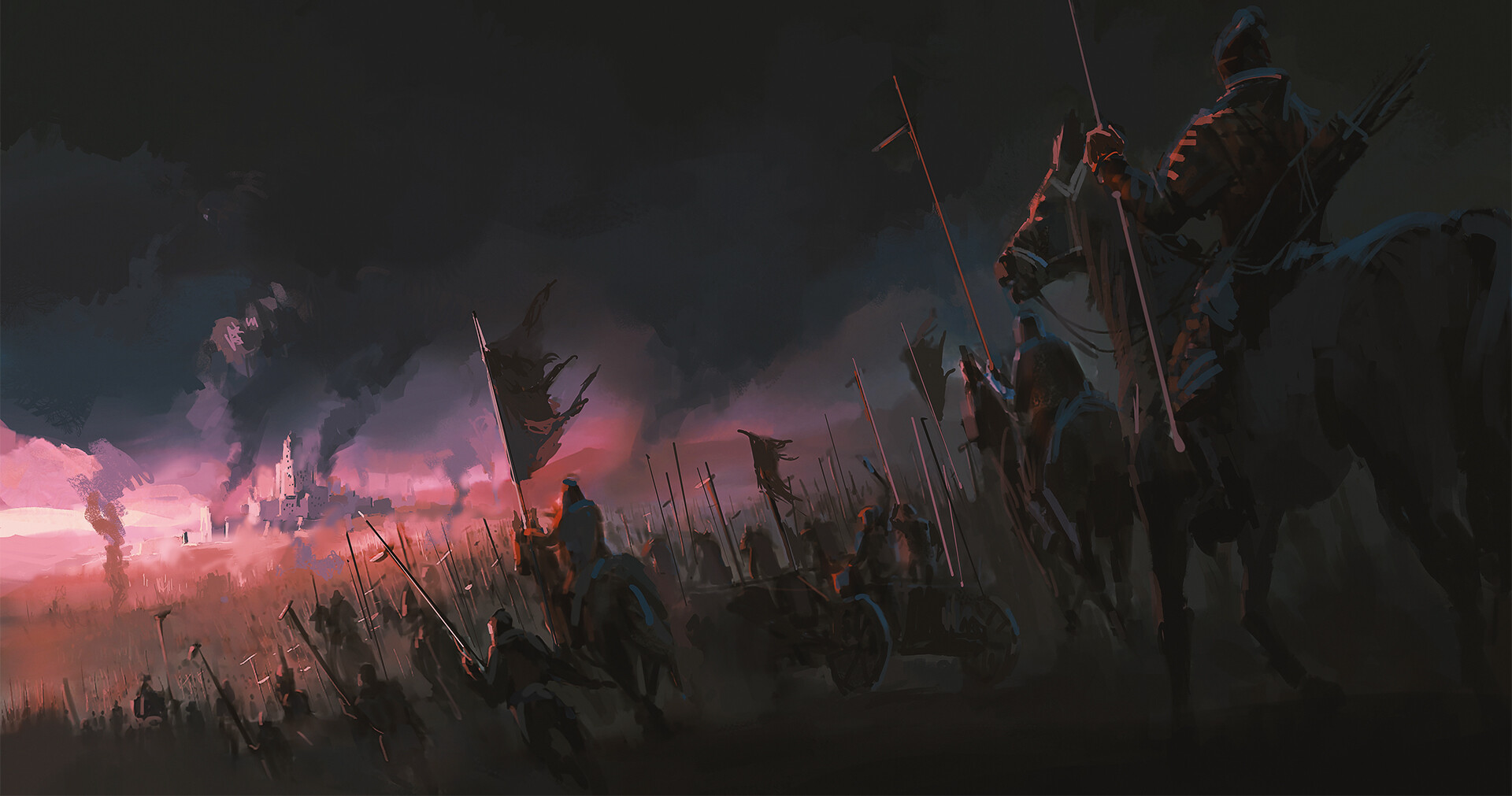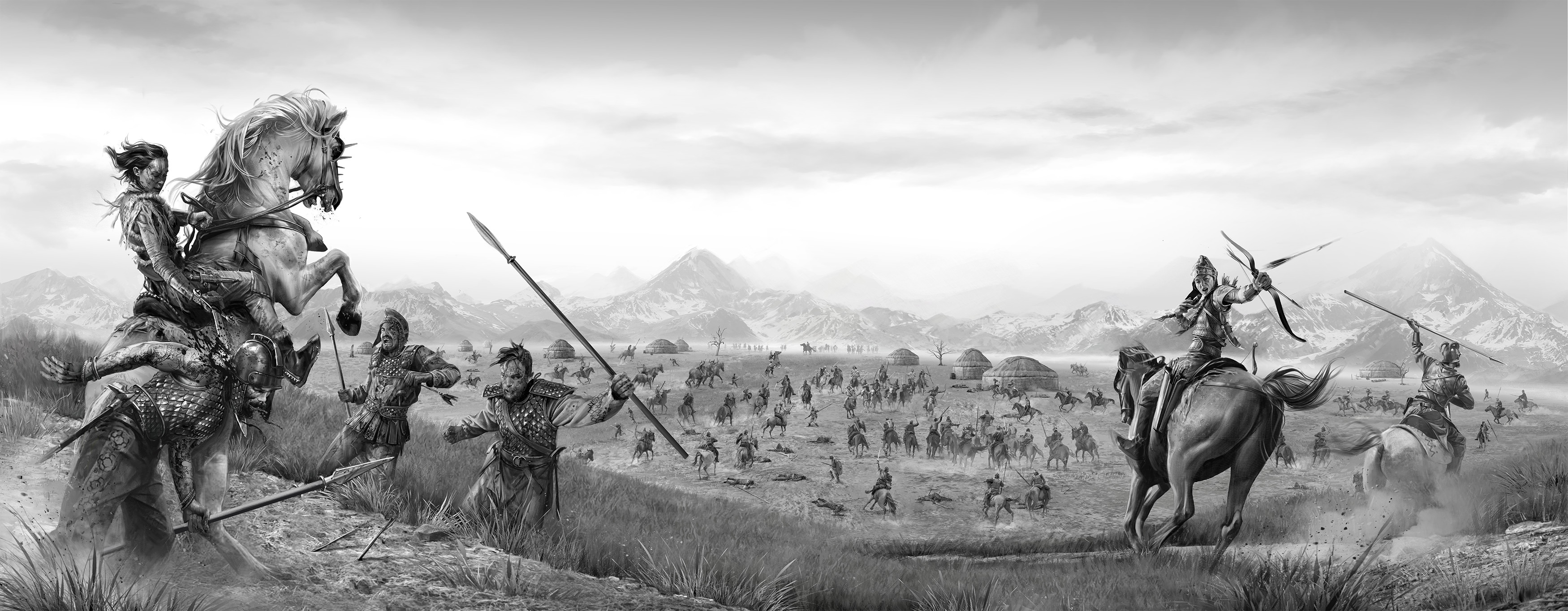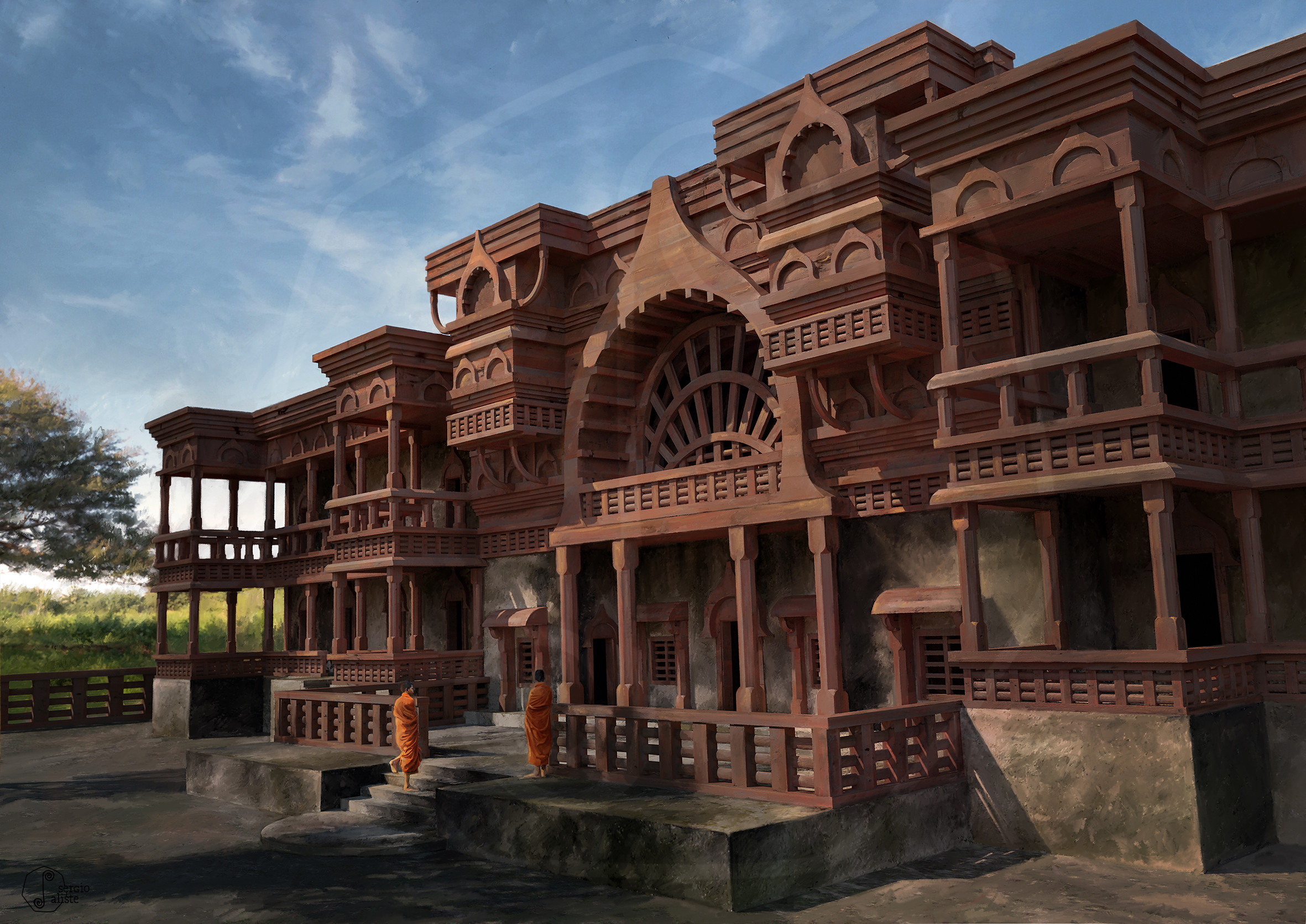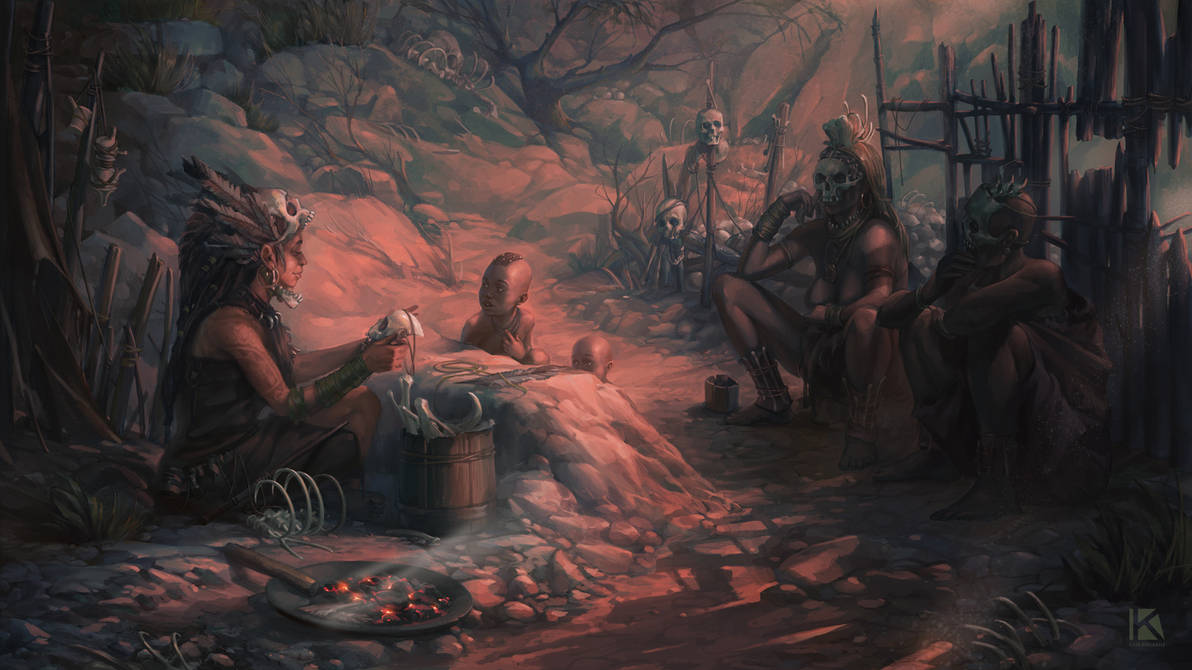Cozamatli - Wandering Tribes of the South
We do not bow to either the Dreamers or the Darkman. We forged ourselves a home in blood and fire and will defend it to the last."Any report on the people of the Far South cannot be complete without mention of the people living high above the jungle. Those tribes not Teluani and not Temoi who with chariots and bronze have carved themselves a place on this once forgotten continent."
The Third Tribe
"It becomes clear rather quickly upon seeing them that the Cozamatli, as the Teluani call them, are a group distinct from the other major peoples of the Far South. They are taller than the Teluani and most Temoi, usually by about a head if not more. However, they do not share either the broad backs of the Teluani or the powerful extremities of the Temoi, being of a much slimmer build overall."
"Of all the people of Inferra, the Cozamatli are perhaps the lightest in terms of complexion. Their skin is closer to that of the average Rhomeian with a noticeable reddish tint. Body hair is another thing to note for it seems to be rougher, thicker, and more prevalent among these tribes, some rather unfortunate cases appearing to possess an animal-like body fur. Such occasions are very rare, however."
"Their faces are harsh; I can't call them by any other word. Sharp edges, almost hawkish in nature, with thin eyes of dark greens and blues. Smiles laden with hidden danger and voices as smooth as the sound of stone grinding against stone complete the image of a people that one would do wisely not to anger and transgress against. Well, that is something that holds true for all people of this land."
From Beyond the Dawn Wall
"Unlike both Teluani and Temoi, the origin of the Cozamatli is hard to discern. Going by Teluani records, they appear around the source of the Efesena, deep in the foothills of the Dawn Wall, some time after the year 2900 DA.
In relatively short order they drove both Teluani and Temoi from the southern highlands and began to launch attacks against cities further north. Large scale incursions only seem to have ceased about three decades ago, when their last Tepactli, a sort of High King if I understand it correctly, was slain outside the walls of Teoktilan.
Small scale raiding is a constant, however. While their intended goal, to gain the fertile lands along the lower banks of the Efesana, was never reached the Cozamatli have managed to establish themselves in a vast territory that stretches in a crescent from the Spine of Colhi to the upper reaches of the Hydyan. One should not think them a unified force, however. The Cozamatli rarely act as one, consisting of a number of tribes and tribal confederations that fight one another as often as they do the Teluani. Among them, five stand out above the rest in terms of power:"
Naskani - The Miners
"Originally a minor tribe, the Naskani rose to prominence when they claimed the great mine of Colhucan for themselves. Building a city within the mine, they began to mass export the metal riches of their new home, gaining great wealth in the process. The Naskani are one of the few fully sedentary tribes among the Cozamatli."
No'tzo - The Vultures
"Rather infamous, even among their own kind, this tribe worships the death god Hexti and is known to practice ritual grave robbing, corpse desecration and even cannibalism. They dwell furthest west, where the highlands merge with the horrid jungle beyond the edge of civilization."
"Rather infamous, even among their own kind, this tribe worships the death god Hexti and is known to practice ritual grave robbing, corpse desecration and even cannibalism. They dwell furthest west, where the highlands merge with the horrid jungle beyond the edge of civilization."
Henacti - The Priests
"Not only do these people own one of the most holy sites of the Cozamatli, they also thrive when confronted with all things spiritual. Members of this tribe can be found all over the highlands, acting as priests, dream diviners, temple wardens and spiritual healers."
"Not only do these people own one of the most holy sites of the Cozamatli, they also thrive when confronted with all things spiritual. Members of this tribe can be found all over the highlands, acting as priests, dream diviners, temple wardens and spiritual healers."
Sekeski - The Plainriders
"Even in a culture as fond of the chariot as the Cozamatli are, the Sekeski stand out. Their mastery of the vehicle is beyond compare and nowhere in the known world can one find chariots as finely crafted as here. From their territory in the central highlands, they regularly attack the north."
"Even in a culture as fond of the chariot as the Cozamatli are, the Sekeski stand out. Their mastery of the vehicle is beyond compare and nowhere in the known world can one find chariots as finely crafted as here. From their territory in the central highlands, they regularly attack the north."
"Most warlike among the Cozamatli, the Ibunaki are a fierce and hardy people that dwells in the southern highlands. Fully devoted to the worship of a war goddess, they are known to launch ritualistic campaigns that target Teluani, Temoi and Cozamatli alike and not a day passes that their armies do not march to battle."
On the Afterlife
"The most dominant faith of the southern tribes is particular in such that it drastically deviates from the beliefs of the other peoples of Inferra. Most Cozamatli do not believe in a single great deity, nor do they worship ancestral spirits or natural forces. Instead, they, with the notable exception of Ibunaki and No'tzo, follow a creed that translates to "The Twelve Divine Realms".
According to their cosmology there exist Six Heavenly Kings, each with two realms to govern over. One of these is situated above the highest heavens, serving as both ethereal court and gathering place of the souls of the perished, the other is located on the mortal earth and includes the natural forces a King presides over.
While there are a number of different interpretations as to the inner workings of this system, the most common holds that the Kings co-exist with one another and that each possesses a list of qualities a soul has to fulfill before being granted entry to one of the heavenly realms. If all six remain barred, the soul will simply return to earth and be reborn, giving them another chance to live a life in accordance with the gods."
Between Temple and Grassland
"There are two major characteristics of Cozamatli life that make them differ from their southern brethren:"
"One exception are the aforementioned Naskani, who after taking the highlands of Colhucan have settled within the mines that mark these dusted regions. They are known to rarely move, except when volcanic activity within the Spine of Colhi threatens one of their many outposts and mining shafts."
Life on the Move
"They are best described as seasonal nomads, following their herds of equine animals across the grassland of the south. Whenever the rain and dry seasons reach their height, making travel difficult at best, the Cozamatli will settle until such an extreme has passed. Over centuries, they have developed a system of easy to build, wooden structures enabling them to raise cities capable of holding thousands in a few days. When a tribe moves across the southern highlands, it rarely does as one unit. Smaller clans and trade caravans may break off and move along different routes or to contact another tribe. Additionally, there is a veritable army of scouts that moves between tribes to ensure that potentially violent conflicts over land or water do not occur."
"They are best described as seasonal nomads, following their herds of equine animals across the grassland of the south. Whenever the rain and dry seasons reach their height, making travel difficult at best, the Cozamatli will settle until such an extreme has passed. Over centuries, they have developed a system of easy to build, wooden structures enabling them to raise cities capable of holding thousands in a few days. When a tribe moves across the southern highlands, it rarely does as one unit. Smaller clans and trade caravans may break off and move along different routes or to contact another tribe. Additionally, there is a veritable army of scouts that moves between tribes to ensure that potentially violent conflicts over land or water do not occur."
Centers of the Faith
"One part of the southern people defies this trend, living in what is best described as large wooden palaces, appearing to be a fusion of villa and fortress. These structures are the temples of the Cozamatli, the earthly seats from which the Heavenly Kings hold sway over the mortal world. Their mortal servants are known as "Henoct'Itza" and the head priests as "Henacti". From marriage ceremonies to burial rituals and everything in between, the palaces of the Divine Kings are the spiritual heart of the Cozamatli. It does not surprise then that one can easily find many a settlement, however temporary, in the vicinity of one such building. Same goes for graveyards, which surround them in such abundance that the Teluani speak of "dead lands" when referring to them."
"One part of the southern people defies this trend, living in what is best described as large wooden palaces, appearing to be a fusion of villa and fortress. These structures are the temples of the Cozamatli, the earthly seats from which the Heavenly Kings hold sway over the mortal world. Their mortal servants are known as "Henoct'Itza" and the head priests as "Henacti". From marriage ceremonies to burial rituals and everything in between, the palaces of the Divine Kings are the spiritual heart of the Cozamatli. It does not surprise then that one can easily find many a settlement, however temporary, in the vicinity of one such building. Same goes for graveyards, which surround them in such abundance that the Teluani speak of "dead lands" when referring to them."
Even the bravest warrior will begin to waver once he sees these savages in their wagons come thundering toward them, screaming like wild monkeys all the while.
Origin
Outer Lands
Class
Young Tribes
Status
Alive
Spoken Languages
Cozacani
Teani
Outer Lands
Class
Young Tribes
Status
Alive
Spoken Languages
Cozacani
Teani
Related Locations
"Something that astound me at first was the seeming reliance of the southern people on Bronze as the main material for war and industry. Something that seems quite strange for a civilization advanced enough to produce high quality steel in large quantities. I did make more extensive inquiries into the matter and have discovered two unique characterisitics of Inferra in that matter:
"Tin and copper seem more abundant than iron, making the production of bronze viable economically. Additonally, they seem to have developed a way to forge a special form of Bronze that seems equal to steel. Translated a term like "Hardened Bronze" is perhaps most fitting. It does hold up to the claims and is used intermitendly with steel. The Cozamatli especially seem to favour it."
Conquest of the Iron Land
"Perhaps the most decisive event in the younger history of the Cozamatli is the conquest of Colhucan in 2962 DA. A coalition of Naskani and Ibunaki managed to vanquish the armies of Teoktilan, shaking the city's hegemony in the process and took the largest mineral deposits on the continent. Although the coalition broke apart in the following decade, the Naskani managed to retain control of the Iron Land. In the centuries since they have settled the region and risen to become one of the great powers of the south, fuelling war of any sort with their mines."
Spiritual Life
"The Cozamatli do not seem to pursue their faith in the same manner that say Ferans or Illigarans do. Wherever or not one will enter the court of one of the Divine Kings hinges solely on the actions committed during a life and if they are accepted by one of those godly beings. Wherever or not one prays, regrets, asks for forgiveness and so on is not important, they will not change the outcome of your cycle. As a result, prayer and other such daily rituals are pretty much non-existent outside of a few select occasions such as funerals and births."
"This way, while practiced by the majority of southern tribes, is not the only one found among the Cozamatli. There is the Way of the Vulture, practiced by the barbaric No'tzo, of which there will be no more mention here for I cannot in good consciounce spread that blood crazed savegery. A third faith of note is that practiced by the Ibunaki, the "Way of War" which is a fully devoted to the worship of a single deity of war with all the implications that brings."








Comments